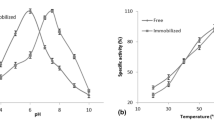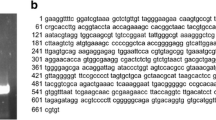Abstract
α-Amylase production was studied in Bacillus amyloliquefaciens in aqueous two-phase systems composed of polyethyleneglycol (PEG)/dextran T500. Cells and enzyme were obtained in different phases when phase systems were applied to the growth media. Effects of different molecular weights and concentrations of polymers on differences of enzyme separation were established. The effect of PEG used in the system to the release of enzyme was investigated.
Similar content being viewed by others
References
Albertsson, P.A. 1986 Partition of Cell Particles and Macromolecules pp. 1–8. New York: Wiley-Interscience Publishers. ISBN 0–471–82820–3.
Andersson, E. & Hahn-Hägerdal, B. 1988 High concentration of PEG as a possible uncoupler of the proton motive force α-amylase production with Bacillus amyloliquefaciens in aqueous two-phase systems and PEG solutions. Applied Microbiology and Biotechnology 29, 329–336.
Andersson, E. & Hahn-Hägerdal, B. 1990 Bioconversions in aqueous two-phase systems. Enzyme and Microbial Technology 12, 242–254.
Andersson, E., Johansson, A.C. & Hahn-Hägerdal, B. 1985 Alpha-amylase production in aqueous two-phase systems with Bacillus subtilis. Enzyme and Microbial Technology 7, 333–338.
Andersson, E., Ramgren, M. & Hahn-Hägerdal, B. 1987 The influence of PEG on α-amylase production with Bacillus species. Annals of the New York Academy of Sciences, Biochemical Engineering 5 506, 613–616.
Brooks, D.E., Sharp, K.A. & Fisher, D. 1985 Theoretical aspect of partitioning. In Partition in Aqueous Two-Phase System: Theory, Methods, Uses and Applications, eds. Walter, H., Brooks, D.E. & Fisher, D. pp. 11–84. Orlando: Academic Press Inc. ISBN 0–12–733861–6.
Gaiker, V.G., Bodhanka, S.S. & Latha, V. 1996 The effect of surface active additives on the partitioning of proteins and enzymes in aqueous two-phase systems. Journal of Chemical Technology and Biotechnology 67, 329–332.
Hotna, S. & Banik, R.M. 1997 Production of alkaline protease by B. thuringiensis H 14 in aqueous two-phase systems. Journal of Chemical Technology and Biotechnology 69, 5–10.
Kroner, K.H., Hustedt, H. & Kula, M.R. 1984 Extractive enzyme recovery: economic considerations. Process Biochemistry October, 170–179.
Lee, Y.H. & Chang, N.H. 1980 Production of alkaline protease by Bacillus licheniformis in an aqueous two-phase system. Journal of Fermentation and Bioengineering 22, 2393–2398.
Monsan, P. & Combes, D. 1984 Effect water activity on enzyme action and stability. Annals of the New York Academy of Sciences, Enzyme Engineering 7 434, 48–60.
Pfueller, S.L. & Elliot, W.H. 1969 The extracellular α-amylase of Bacillus stearothermophilus. Journal of Biological Chemistry 244, 48–54.
Stredansky, M., Kremnicky, L., Sturdik, E. & Feckova, A. 1993 Simultaneous production and purification of Bacillus subtilis α-amylase. Applied Biochemistry and Biotechnology 38, 269–276.
Ülger, C. & Çırakoğlu, Ç. 2001 α-Amylase production by Bacillus subtilis and B. amyloliquefaciens in different PEG solutions. World Journal of Microbiology and Biotechnology 17, 93–94.
Author information
Authors and Affiliations
Rights and permissions
About this article
Cite this article
Ülger, C., Çırakoğlu, Ç. α-Amylase production in aqueous two-phase systems with Bacillus amyloliquefaciens. World Journal of Microbiology and Biotechnology 17, 553–555 (2001). https://doi.org/10.1023/A:1012238016661
Issue Date:
DOI: https://doi.org/10.1023/A:1012238016661




